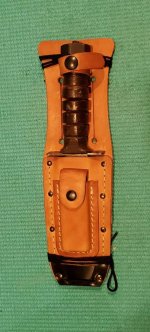Gentlemen:
It goes back a little further than what has been discussed here so far. To understand the Jet Pilot Survival Knife (which later underwent several nomenclature changes) one needs to know about it's immediate predecessor blade, the Pilot Survival Knife or technically speaking the "Knife, Survival, Pilot's (with sheath)". That was a 5 inch, unfullered, fixed blade knife that was adopted by the U.S. Navy's Aeronautics Equipment Board in 1953 under specification MIL-K-8662(AER). This knife was produced by Imperial, Schrade Walden Cutlery Co. and Camillus Cutlery. The image below shows the Imperial PSK that I have in my collection.

During the early 1950's the US Air Force was using a different fixed blade knife for pilot and other aircrew survival purposes. That knife was the Boker Model 155. It is rarely encountered today and few people outside of US military knife collecting circles are even aware of its existence. While other fixed knives were also used by the Air Force during this time the Boker is what was packed in the Survival Kits utilized by the Strategic Air Command. The image below shows the Boker in my collection.

It was the Navy, not the Air Force, which later once again took another stab at getting an improved knife for aviators. That is when Marble Arms Co. got involved. It bid on a Navy contract to supply 23,857 Pilot Survival Knives. (It did not win the bid.) As an alternative it offered to provide the Navy's Aeronautics Equipment Board with an improved knife made to more stringent specifications. The basis for that improved knife was to be the Marbles "Expert" #545 knife with saw teeth added to the spine.
Further development of that concept lead to the 6 inch Jet Pilot Survival Knife. The Navy ended up buying 5000 of the Marbles knives for $60,000 and paid an additional $25,000 for the rights to manufacture the knife by any vendor. Marbles produced beautiful, well crafted knives under this contract but they were far more expensive to make than the Navy wanted. Thus, Marbles failed to secure the follow on contract which was awarded to Camillus. Camillus had a long history of USGI knife production and had the skill and know-how to produce military knives cheaply and at high volume.
So, both the earlier Pilot Survival Knife and its successor, the Jet Pilot Survival Knife, were at the start Navy blades. As stated earlier the JPSK was later adopted by all branches of the US military. It was never an Air Force only knife. My friend Frank Trzaska, US knife researcher and author, is responsible for having ferreted out most of this information.
HTH.
Regards,
Charlie









